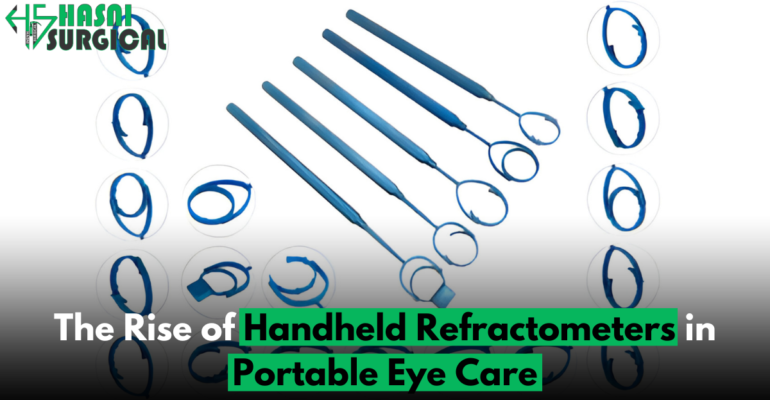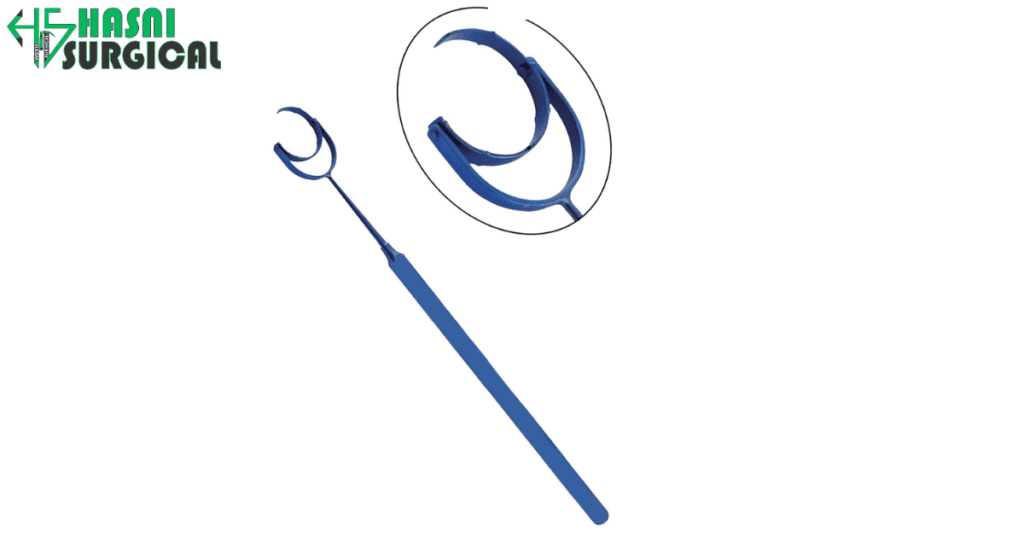The Rise of Handheld Refractometers in Portable Eye Care
September 3, 2024 2024-11-21 6:05The Rise of Handheld Refractometers in Portable Eye Care

The Rise of Handheld Refractometers in Portable Eye Care
Introduction:
Eye Care
Healthcare innovations are advancing, with portable refractometers transforming portable vision testing.
Handhelds have transformed eye exams from clinic-bound to portable and convenient.
Refractometers are making vision testing accessible to all, bringing clear and accurate vision to communities everywhere.
Explore the impact of refractometers on portable eye surgery, their benefits, applications, and future potential. Discover how this technology is transforming modern eye care for millions worldwide.

Understanding handheld refractometers:
Refractometers are sophisticated optical instruments designed to measure the refractive error of the eye quickly and accurately. Refractive error, causing blurred vision, includes myopia, hyperopia, and astigmatism.
Refractometers usually have a compact, lightweight body with an eyepiece, focusing mechanism, and measurement scale. Some modern models have digital displays and electronic components for added functionality.
Handheld refractometers work by aligning with the patient’s eye and focusing on a distant target. The practitioner adjusts the optical power to find the correct refractive correction for optimal vision. This correction is usually expressed in diopters, which represent the reciprocal of the focal length in meters.
One of the key advantages of refractometers is their portability. This makes them ideal for mobile clinics, outreach programs, and humanitarian missions with limited access to eye surgery.
They can accommodate a wide range of individuals, including children, elderly patients, and those with mobility issues.

Early detection of vision issues is key to optimal development, and these devices help identify and address refractive errors swiftly.
Refractometers are a major advancement in portable eye treatment, providing a convenient tool for visual acuity assessment. Future innovations will boost their impact on global eye health.
Let’s explore the benefits of handheld refractometers in portable eye care:
1. Accessibility: Refractometers improve access to eye surgery services by breaking down geographical barriers. They can be easily transported to remote areas, reaching populations with limited access to traditional eye surgery facilities. This accessibility is crucial for people in rural areas or regions with poor healthcare infrastructure.
2. Early detection and intervention: Timely detection of vision problems is essential for preventing long-term complications and improving patient outcomes. Handheld refractometers enable early detection of refractive errors, allowing for prompt intervention and treatment. Early identification of vision issues helps prevent more serious conditions and lessens the impact on patients’ quality of life.
3. Customization and Personalization: Every patient is unique, with individualized vision needs and preferences. These refractometers facilitate personalized care by providing accurate measurements tailored to each patient’s specific requirements. This customization ensures that corrective lenses are precisely prescribed, leading to optimal visual acuity and comfort for the patient.
4. Convenience for Practitioners: Portable eye care devices like handheld refractometers simplify vision testing for practitioners, providing convenience. These devices are easy to use and require minimal setup, allowing practitioners to conduct comprehensive eye exams efficiently. With quick, accurate measurements at hand, practitioners can deliver quality care without being hindered by cumbersome equipment or procedures.
5. Patient Engagement and Education: These refractometers enhance patient engagement by involving individuals in the vision testing process. Patients can observe the measurements being taken in real-time, fostering a greater understanding of their eye health and treatment options. This transparency promotes patient empowerment and encourages active participation in their own eye surgery journey. Practitioners can use handheld refractometers to educate patients on refractive errors and the need for corrective lenses.

6. Improved outcomes: Ultimately, the use of handheld refractometers contributes to improved clinical outcomes and patient satisfaction. These devices provide precise refractive measurements, ensuring accurate prescription of corrective lenses for improved visual acuity and comfort. This boosts quality of life and eye surgery satisfaction.
7. Versatility in Settings: Refractometers are versatile enough to be used in various settings beyond traditional clinical environments. They are well-suited for mobile clinics, outreach programs, schools, nursing homes, and even home visits. This versatility ensures eye care services reach diverse populations and meet various eye health needs wherever they’re most needed.
Handheld refractometers offer numerous benefits in portable eye care, including better accessibility, early detection, and increased patient engagement. They help practitioners deliver top-notch, personalized eye surgery anywhere.
Expanding on handheld refractometers shows their versatility in eye surgery and beyond.
1. School vision screenings: Refractometers are invaluable tools for conducting vision screenings in schools. These screenings help identify vision problems in children at an early age, allowing for timely intervention and treatment. Eye care professionals can quickly check students’ vision at schools using handheld refractometers.
2. Mobile Clinics and Outreach Programs: Mobile clinics and outreach programs are vital for eye care in remote or underserved areas. They help practitioners provide exceptional, personalized eye care anywhere.
3. Geriatric Care Facilities: Refractometers are ideal for geriatric care. Older adults may have difficulty traveling to traditional eye care clinics, making it challenging to receive regular vision assessments. Handheld refractometers enable eye care at facilities, eliminating travel for residents.
4. Military and Field Medicine: Refractometers quickly assess vision in military settings, aiding treatment and readiness. These devices help military medical personnel evaluate visual acuity swiftly, aiding in timely treatment and ensuring mission readiness.
5. Telemedicine and Remote Consultations: Refractometers are vital for virtual eye exams, enabling expert vision assessments from home. They’re useful for those with mobility issues, rural areas, and telehealth users.

6. Eye care is vital in humanitarian missions and disaster relief. These refractometers enable medical teams to assess the visual health of affected populations quickly and efficiently, even in challenging environments. These devices offer vision care in emergencies.
Future Trends and Developments
As technology advances rapidly, refractometers for portable eye care have a promising future. Here are some potential trends and developments that we can expect to see:
1. Integration with Digital Platforms: Refractometers will integrate with digital platforms and EHR systems for real-time data access and analysis. This will enhance clinical decision-making and support remote consultations via telemedicine, allowing patients to receive eye care from home.
2. Artificial Intelligence (AI) Integration: AI-powered algorithms hold the potential to enhance the accuracy and efficiency of handheld refractometers. By leveraging machine learning, these devices analyze refractive error data more effectively, enhancing diagnostics and personalizing treatment. AI can automate screening for glaucoma and diabetic retinopathy, boosting portable eye care.
3. Enhanced Portability and Ergonomics: Future iterations of refractometers are likely to feature enhanced portability and ergonomic design. These devices may become even smaller, lighter, and more user-friendly, making them easier to carry and operate in diverse environments. Ergonomic upgrades, like adjustable angles, will improve comfort and usability.
4. Augmented Reality (AR) and Virtual Reality (VR) Applications: AR and VR could enhance vision tests with refractometers. They offer virtual training for eye care professionals in assessing refractive errors.
5. Continuous Monitoring and Remote Care: Refractometers with continuous monitoring can enable remote tracking of patients’ visual health. These devices track refractive error and visual acuity to manage chronic eye conditions like myopia and presbyopia. This technology allows patients to actively manage their eye health with support from eye care professionals as needed.
6. Multifunctionality and Interoperability: Future refractometers might include extra features like ocular biometry, intraocular pressure measurement, and anterior segment imaging. This would allow for comprehensive eye exams with one device, streamlining diagnostics and boosting clinical efficiency. Better interoperability will enhance their role in integrated eye care workflows.

Conclusion:
Future refractometers might include extra features like ocular biometry, intraocular pressure measurement, and anterior segment imaging. This would allow for comprehensive eye exams with one device, streamlining diagnostics and boosting clinical efficiency. Improved tool interoperability will enhance eye care workflows.
Conclusion:
The rise of refractometers marks a significant advancement in portable eye care, offering convenience and efficiency for vision testing. These compact devices are crucial in remote and underserved areas with limited access to traditional eye care. Their portability, versatility, and affordability make them essential for healthcare practitioners, allowing them to deliver timely interventions in various settings.
Looking ahead, refractometers are set for more innovation and refinement. Technological advances are enhancing capabilities, with digital platforms and telemedicine enabling remote consultations and teleophthalmology. Ongoing research seeks to improve the accuracy and reliability of these devices, ensuring better outcomes for patients globally.
Refractometers make eye care accessible to everyone. By using portable technology, we move towards a future where everyone can enjoy clear vision and ocular health. These devices are symbols of hope, paving the way for limitless sight.

